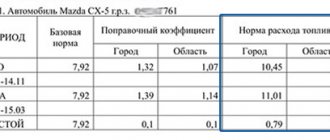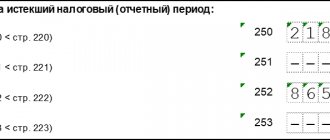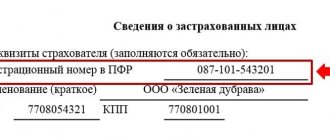General information about submitting reports using Form 2-TP (Vodkhoz)
Based on the “Regulations on the conditions for the mandatory provision of primary statistical data...”, approved by Decree of the Government of the Russian Federation of August 18, 2008 No. 620, primary statistical data are mandatory provided free of charge by respondents , namely:
- legal entities;
- state authorities and local governments;
- branches, representative offices, divisions on the territory of the Russian Federation of foreign organizations;
- individual entrepreneurs;
- small and medium-sized businesses (provide a simplified form).
Attention: subjects of official statistical registration (for 2-TP (Vodkhoz) - Territorial bodies of Rosvodresursy) inform respondents free of charge (including in writing) about the conduct of federal statistical observation in relation to them according to specific forms of federal statistical observation, mandatory for submission (Resolution No. 620).
By Government Order No. 671-r dated 05/06/08, responsibility for collecting and processing information on the use of water resources of the Russian Federation, as well as submitting it to Rosstat, is assigned to Rosvodresursov (Water Management) . Respondents (organizations that report according to Form 2-TP (Vodkhoz) submit the document to the Water Department whose territory they belong to.
In total, there are 14 water departments in Russia - Nevsko-Ladoga, Moscow-Oka, Verkhne-Volzhskoye, Verkhne-Obskoye and other basin water departments.
In order to organize the collection of statistical information on the use of water resources, Order No. 230, issued by Rosstat on October 19, 2009, approved the reporting form 2-TP (Vodkhoz).
This reporting form is annual. The respondent provides information for the reporting year at the place of its activities on the date appointed by the water department. The last day for submission is January 22 (inclusive), following the reporting period.
More details about the service on page 2-TP.
What data is included in reports 3.1, 3.2, 3.3?
The first form 3.1 contains the following data about the water body from which the subject is drawing on the basis of the relevant agreement or decision of the local government authority:
- His name;
- The code of its type, for example, if from the sea, “10” is indicated, for rivers the value “20” is used, and for a reservoir or pond the value “40” is taken;
- Water source code, which is assigned by the territorial water protection authority;
- The number of the outlet and its coordinates, which allow you to accurately determine it on the ground;
- Acceptable and actual number of malicious resets.
The report in the following form 3.2 must contain the following information about the water resource facility:
- His name;
- The code of its type, for example, if from the sea, “10” is indicated, for rivers the value “20” is used, and for a reservoir or pond the value “40” is taken;
- Water source code, which is assigned by the territorial water protection authority;
- The number of the outlet and its coordinates, which allow you to accurately determine it on the ground;
- Acceptable and actual number of malicious resets.
The report on the latest form 3.3 differs from the previous one in that information about pollutants is entered in its columns:
- Their name and code;
- Volume of actual discharge;
- Approved standards for the amount of permissible discharge;
- An established limit on the amount of their permissible discharge.
When filling out the form, water volumes are indicated in thousands of cubic meters accurate to hundredths (the second decimal place). If the subject does not collect water, it may not submit a report in Form 3.1.
Business entities required to submit form 2-TP (Vodkhoz)
The list of those who are required to pass 2-TP (Vodkhoz) is established by Rosvodresurs. Such economic entities include legal entities, individual entrepreneurs and their divisions that use water , as well as:
- discharge (discharge) wastewater;
- withdraw water resources from natural reservoirs or reservoirs in a volume of 50 cubic meters. m for a day or more ;
- receive water resources in the amount of 300 or more cubic meters from the water supply system . m during the day (except for agricultural needs);
- agricultural enterprises that withdraw 150 or more cubic meters per day to support their activities. m of water resources ;
- enterprises using water supply circulation with a capacity of 5 thousand or more cubic meters. m per day , regardless of the volume of intake.
Procedure for compiling a report
The form reflects information about each separate division and legal entity without separate divisions. The report must be submitted at the place where economic activities related to the use of water resources are carried out.
It is recommended to generate the report using the IAS 2-TP (Vodkhoz) program - the full name is “Information and analytical system for statistical processing of information on water use according to the federal statistical observation form (Vodkhoz).” This program is freely available on the official websites of territorial water departments (for example: Mosoblvodkhoz, Federal Water Resources Agency). You can download it completely free of charge. The program is recommended for use in many regions of Russia, and in some, its use is mandatory.
Fig.1. Launch of the IAS 2-TP program (Vodkhoz)
The peculiarity of this program is that when filling it out, you must select from the proposed list the branch of the body that will receive reports (it will not be possible to change it later). That is, on one computer it is possible to form swelling only in Rosvodresursy of one region (Fig. 2).
Fig. 2 Select in IAS 2-TP (Vodkhoz) the water resources department of your water department
First, we fill out the general data window: year, name of the organization, address, OKPO, OKVED, information about the person responsible for the delivery, and more.
The OKATO code (all-Russian classifier of administrative-territorial division of objects) must be selected in accordance with the WCU (water management area) used. Otherwise, when filling out form 2-TP (Vodkhoz), the discrepancy between the VKhU and OKATO will not make it possible to form it correctly. The program will issue a warning that the form data is incorrect. Also, the codes of the water body and the distance to the mouth must be in accordance with each other.
Secondly, fill out the second tab (Section 1). We enter data on the basis on which water is used in your organization (agreement, license, decision); information about “water suppliers”; information on water supply; monthly and annual water intake in cubic meters; data on the type of water supply, its volume (Fig. 3).
Rice. 3. Section 1 of the 2-TP report (Vodkhoz): “Water taken from natural sources, received from suppliers, used, transferred and lost”
Thirdly, we enter the data in section 2 “Water disposal”. Again, fill in the information about the basis on which water disposal takes place in the organization (decision, license). Water quality codes, OKATO, VKHU. Data on water discharge in cubic meters, discharge water receivers; volume of water discharged into water bodies, types of wastewater, including storm water (Fig. 4).
Fig.4. Section 2 “Water disposal”
After filling out the module, you need to save the file in Excel form, then download the same report in tp2 format and transfer the document to electronic media (flash card, disk).
What are the consequences of not having a report and is it possible to make the process of creating one easier?
If a businessman violates the procedure for submitting a water management report or indicates false data in it, he may be punished.
IMPORTANT! The amount of fines under Art. 13.19 of the Administrative Code are: from 10,000 to 20,000 rubles. — for officials, from 20,000 to 70,000 rubles. - for legal entities.
You can facilitate the preparation of a water management report using specialized automated programs. For example, such an assistant can be IAS 2-TP Vodkhoz - an information and analytical system for statistical processing of information on water use in the form of federal statistical observation (vodkhoz).
Its use is recommended in various regions of our country, and in some it is mandatory when preparing a “water” report.
Reporting process 2-TP (vodkhoz)
The notification of reporting 2-TP (vodkhoz) comes to the address of the enterprise's location , which is indicated in the Unified State Register of Legal Entities or Unified State Register of Individual Entrepreneurs (for individual entrepreneurs). It indicates a specific date when a representative of the organization needs to come to the territorial department of the second-tier bank to submit reports.
The notice also lists all the documents that you need to take with you. Namely:
- A legal document evidencing the authority of an official to provide a report on behalf of a legal entity.
- Completed statistical report in form 2-TP (vodkhoz) for the reporting year on paper and electronic (flash drive, disk) media.
The report must be accompanied by:
- electronic file saved from the IAS 2-TP module in tp2 format;
- an explanatory note explaining the changes that have occurred (if the changes are more than 30%) in water use and wastewater discharge in the reporting year in the form that is presented in the notification of statistical observation in Form 2 TP (vodkhoz);
- calculation of surface water volumes (calculation methods are also presented in the appendix to the notification);
- information on monthly wastewater consumption and the mass of discharge of pollutants into water bodies, comparative characteristics of discharge according to the table forms from the notification;
- certificate-notification from Rosstat with the details of the enterprise required to fill out the address part of the 2-TP form (vodkhoz).
In addition, the notification asks authorized representatives to carry with them, but not hand over, a number of documents:
- a program of regular observations of a water body and its water protection zone, agreed upon with the territorial bank;
- approved standards for permissible discharges (if the respondent discharges wastewater into water bodies;
- an agreed upon layout of water intake and discharge sites;
- environmental action plan and certificate of its implementation for the reporting year;
- when taking water from the networks of another enterprise or discharging wastewater into the networks of another enterprise, the volumes of water taken (discharged) agreed upon by these enterprises;
- a license for water use or a license for the right to use subsoil for the extraction of groundwater (if any), a water use agreement or a decision to provide a water body for use).
The report in form 2-TP (Vodkhoz) is submitted on paper in 3 copies (one original, two copies) and in electronic form , attachments to the report in 2 copies. The report is certified by the signature of the official responsible for providing statistical information.
Cover letter for the report
When considering the question of in what cases it is necessary to submit a 2-TP (vodkhoz) report and how to fill out this document, you need to start from the requirements of the regional bank. It is common practice that in addition to all of the above, they require respondents to send letters with reports along with cover letters. They explain how to fill out the form and indicate the following information:
- The presence in the past period of new sources or places of water intake and discharge, respectively;
- The reasons why the above changes occurred;
- Factors due to which the amount of pollution in the wastewater system decreased or increased;
- Other important information that the respondent considers necessary to indicate.



